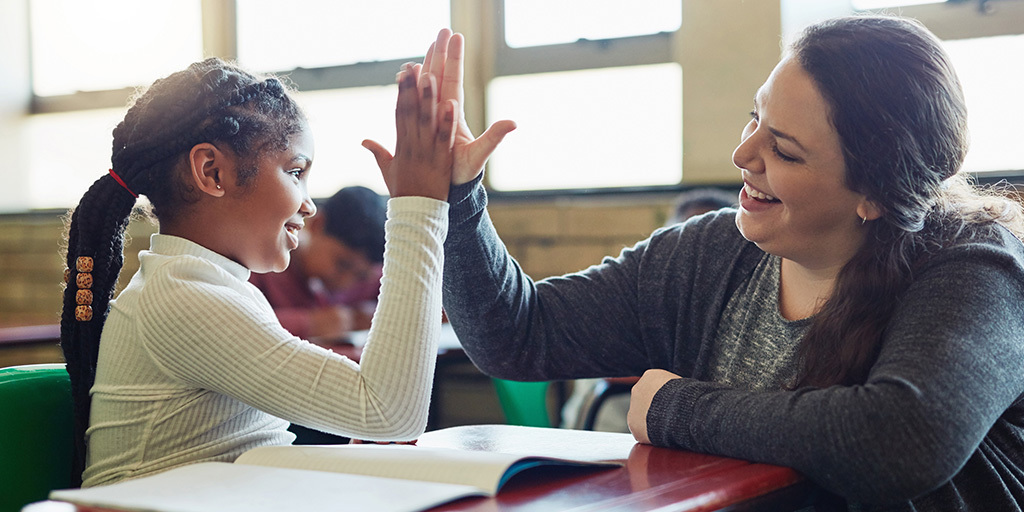Today’s students are inundated with negative influences—whether it’s social media, substance abuse, bullying, mental health issues, or difficult family dynamics. More and more students are coming to school unwilling to take responsibility for their actions, unable to cope with conflict, and lacking resilience and social problem-solving skills. As a result, disruptive behaviors are increasing both inside and outside the classroom, interrupting instruction and forcing teachers to spend precious time on behavior management and discipline.
Often, teachers’ response to poor behavior is focused on punishing the unwanted action so they can go back to instruction as quickly as possible. However, this cycle leads to students repeating the same behaviors, thus perpetuating the battle between managing behavior and focusing on instruction.
If we are truly committed to teaching children, then we must accept that we are responsible for teaching more than academic content. That’s why we should reframe every situation that involves discipline as an opportunity to teach. In this article, we’ll discuss how to approach discipline in a positive way, with a focus on conflict resolution, accountability, and restitution.
Don’t React; Respond
Poor behavior can take its toll on even the most patient staff member—especially when students seem to thrive on pushing your buttons or seem focused on making your day miserable. No matter how stressful these situations can be, the most important thing you can do is keep your emotions in check. When we’re angry or frustrated, we can exhibit several verbal and nonverbal reactions, including frowning, heavy breathing, crossed arms, and an accusatory or combative tone.
However, it’s important to remember that as the leader of your classroom, you are the one who sets the tone for your students. When you react emotionally to bad behavior, you perpetuate a negative environment in your classroom. Instead, make sure to keep your emotions in check and respond thoughtfully rather than reactively. Keep your voice level, your tone neutral, and your body calm. Only then will you be able to use discipline as a positive teaching opportunity.
A Five-Step Protocol for Addressing Misbehavior
During my 17 years as an administrator, I dealt with countless instances of misbehavior; most were minor, while some were serious. In all cases, I used the same protocol and taught my teachers and support staff to do the same.
The following protocol is a teaching tool that focuses on helping the student understand what he or she did, the reasons behind the behavior, how to make better choices in the future, how to make amends to the person or persons affected, and how to be accountable for his or her actions.
The protocol involves asking the student five simple questions. Let’s look at each question using the example of a student punching another student in the lunchroom.
“What reasons did you have for punching someone?”
Never ask why. Every time I asked a student why, the answer was always “I don’t know.” Instead, ask for the reason or reasons. If the student responds with “I didn’t have a reason,” then ask, “If you did have a reason, what would it be?” It works almost every time! A typical response might be “He made me mad by calling me a name.” No matter what the student says, always respond by saying, “Thank you for being honest with me.” Students will visibly relax and be more open to sharing details as you ask them to tell you more. Talking to students in a respectful, non-threatening manner allows them to be more open to learning from their mistakes.
“What are three things you could have done instead of punching someone?”
Most students are able to come up with one thing they could have done differently. The real teaching and learning happen when you push students to come up with two more possible solutions. It helps them think and problem solve. Typical responses I’ve gotten from students include: Tell an adult, walk away, and ask the other student to stop.
“What will you do next time?”
Next, ask students to choose which of the three actions they will take next time. Doing so will give students power and control over their choices. Many times, students misbehave due to a lack of control in their own lives. Give them power rather than stripping them of it. You’ll get great results.
“What can you do to make this right?”
It’s important that students understand they have to make amends for their wrongdoing, which may include apologizing to specific people who were impacted by their misbehavior (e.g., the other student, the teacher in charge, a bus driver). To save face, as many older students need, give students the option to apologize face to face or write a note. Again, it’s important to give them control.
“What do you think should happen to you, based on your actions?”
This is where there must be accountability. It’s not about punishment; it’s about the consequence that results from the bad choices the student made. Oftentimes, when you ask students what they think the consequence should be, their consequences will be much worse than yours. Consequences must be logical and fit the misbehavior—always! For example, a logical consequence for punching someone in the lunchroom might be losing the privilege of eating in the lunchroom for a period of time, a call to guardians, and possible in-school suspension (for first offenses).
Conclusion
Teachers can’t take for granted that students will come to school knowing how to behave. As educators, we need to accept the reality of poor behavior and lead the way in teaching students responsibility and accountability when they make bad choices. By approaching misbehavior as a learning opportunity, we are teaching students how to face mistakes, own them, learn from them, and better themselves. Discipline is an opportunity to do what we do best: teach.






